Fall has finally arrived here in East Tennessee. As the leaves change so should your tactics while you’re out on the water. This is something we think about more as we change our fishing location from the Smokies to our tailwaters andon our annual trip to the Henry’s Fork since all of those places are so radically different. We’re on the water almost everyday so we subtle differences daily over a long period of time, but if you only get out once a month or less the differences will be much greater between trips.
Take note of the water level
This is something that most anglers take for granted but it has a greater impact on your fishing than anything else. If you fish our tailwaters in East Tennessee you probably check to see the generation schedule before you even plan your day so you hit the best water level. On a river like the Clinch this means whether you can wade, whether you need a boat to fish, or whether the river may be too high to even bother going. These different levels are pretty consistent though, so low water on the Clinch is pretty much the same every time you go.
This is not the case when fishing mountain streams. In the case of any one small piece of water there will be an ideal flow, one that’s a little too high, and another when it’s too low. This doesn’t mean flood conditions, drought conditions, and something in between. Spring flows in March and April are usually a bit on the high side without being anything like a flood. Swifter flows and deeper water are common in many places. It also means many areas in the streambed are covered with water. Come back in June and July and these spots will not be dried up, but the flows will be slower and shallower while some of the edges will be up out of the water.
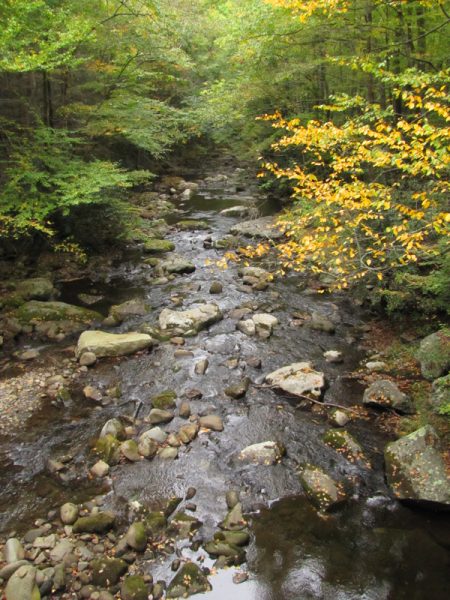
This stretch of water at Tremont is quite low in this photograph but higher flows will create perfect pockets.
This means that perhaps the main rush of water down the center of the stream may have been too swift for fish to hold and feed in spring, but in June is just perfect. At the same time the spots that where you found greedily feeding fish in April are now flowing slowly or have no current at all; not a great spot to find a feeding trout or fool him with an imitation. Occasionally we’ll chat with anglers who talk about the river being “too high to fish” or being really low. That usually puzzles us as we don’t think that’s the case, but most people go back to a few pet spots instead of looking for places with an ideal set up.
No single spot is ideal to fish under all conditions. We’ll fish completely different areas during high flows than medium flows, and yet different areas when flows are low.
Take Note of Water Temperature
Water temperature is something I’m aware of, but don’t get too worried about even though it’s pretty important. The reason is I’ll see anglers check a water temperature and immediately declare the day a complete loss because the water is too cold or too warm. Once again, you’re going to have to move around to find success under different conditions.
Cold water in the mountain streams usually means the fish aren’t rising and nymphs are a safer bet. We’re thinking about water temperatures below 50 degrees which are typical from late fall, through the winter, and into early spring. Even so, steady water temperatures are easier to deal with the falling water temperatures. If the water has been in the high 40’s for a week or more and the weather is similarly steady you’ll probably do OK fishing nymphs and possibly even find a trout willing to take a dry fly in a relatively shallow run of water.
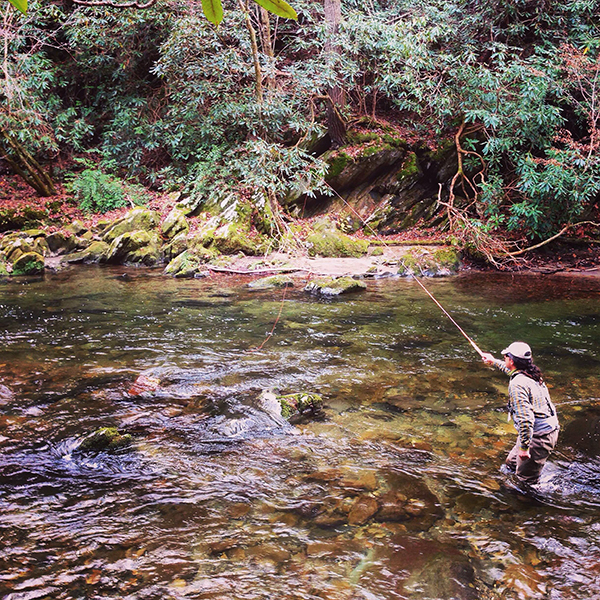
Steady water temperatures and even flows make dry fly fishing a cool weather possibility in the Smokies
The toughest days for us are associated with falling water temperatures. This year our summer lingered well into October but fall weather arrived seemingly overnight. We had one day where the water temperature fell about 10 degrees in about 12 hours. Both Charity and I were on the water guiding that day and trust us, the fish were not happy!
There will always be lower water temperature over night into the morning and rising water temperatures through the afternoon. This is usually just a few degrees but that’s why fishing is typically better in the afternoon than the morning in fall, winter and spring. Try to head for places where the water temperature will be optimal. Those high elevation streams that fished so well in July will probably be slow to dead as the weather chills in the lower elevations. In fact, November weather in the higher elevations is similar to January weather in the lower elevations.
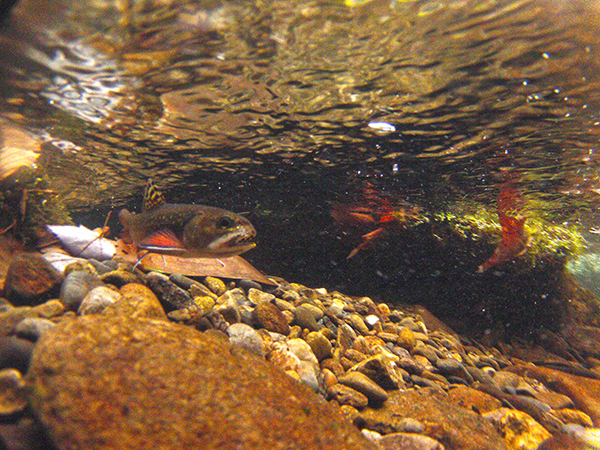
Small streams usually feature fish in shallow water but these places may be too cold for trout to be very active in the winter
The opposite situation can be that fish are very active when temperatures quickly go from cold to warm. This happens during the cold months after a warm front passes through with a warm rain. Fish absolutely are active and feeding under these conditions.
Warm water in the summer presents a different challenge. Summer water temperatures might become marginal and warm water will cause trout to become sluggish to conserve energy. Those high elevation streams were the place to find cold water and active trout. During the cooler months are these same streams may not fish well because they will be colder than the lower elevations. Winter fishing is best on the lower streams that will also get more sun exposure and warm up a little bit.
Tailor Fly Selection to the Conditions
While you need to choose the best spot for the water levels and the weather, you also need to think about your fly selection as well. Many fly fishers might think we mean changing from a Pheasant Tail Nymph to a Copper John or changing from an Elk Caddis to a Stimulator, but that’s not really what we mean at all.
The Smoky Mountain region has a wonderfully long dry fly season that starts in March and goes well into November most years. As a result many locals can take the attitude of dry fly purists and hook plenty of trout. On the other hand there are many visiting anglers who come from areas where fish almost never rise and nymphing is the standard method. Neither method should be used all the time without any consideration for water levels or temperatures.
Higher water usually calls for nymph tactics as does colder water temperatures. Lower water levels and warmer water (55-65 degrees) can be pretty good for dry flies and believe it or not, sometimes pretty bad for nymphing. A heavy nymph rig with a large strike indicator can actually spook trout unless the water is flowing pretty quickly.
Fall is a transitional time of year that requires a little more thought when you choose your fly. A typical fall flow in the Smokies features cool but not cold water and afternoon emergences of midges and blue wing olives. This can often mean a dry fly is premium, and while a smaller fly is usually better, most Smoky Mountain trout aren’t sticklers for an exact imitation.
This year we’re seeing relatively high flows in autumn coupled with relatively low water temperatures in the low 50’s or high 40’s. There are some bugs hatching but the higher flows seem to discourage the fish from looking up for such small bugs that only appear intermittently. Some fish will rise in some spots while others refuse to even consider looking to the surface.
This is where we’ve come to rely upon dropper rigs when neither nymphs nor dry flies seem to work consistently. Exact fly patterns aren’t overly important. Use a relatively bushy dry fly that you can see well and match it to the size and weight of the nymph underneath. The nymph should sink well but it shouldn’t sink the dry fly. That defeats the whole purpose of using a dry fly as a strike indicator. Also make the nymph somewhere between 18″ and 30″ deep depending on the size of the stream and the depth of the water.
All takes on nymphs without any fish looking at your dry fly means few if any fish will rise. Numerous takes on your dry fly or even looks and refusals means trout are certainly looking up and the nymph may not be necessary. Trout will often rise to the bushy dry flies we use with dropper rigs but not take them. The same fish will often take a smaller, less bushy dry fly that is similar to what they are feeding upon.
What all this means is that you need to pay attention and be willing to change your fishing spots as well as your flies. You can never know everything before you arrive on the water but one of the many joys fly fishing provides is learning more about the world and creatures in it.
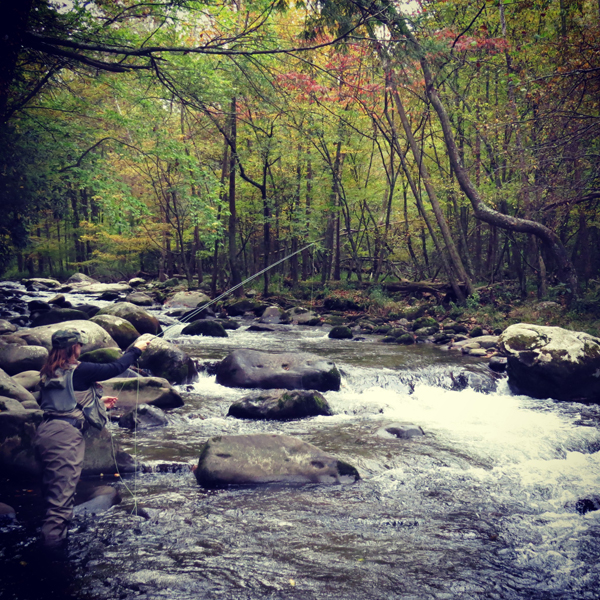
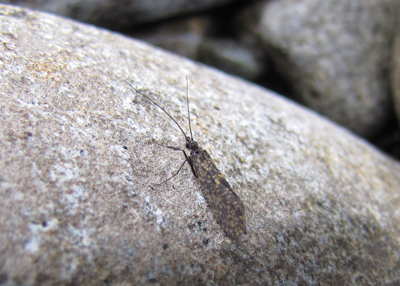
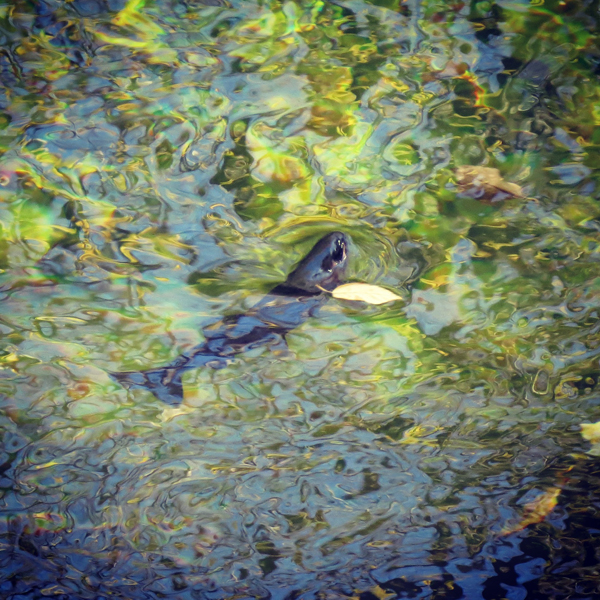
Scott Crouse says
Great article! Very informative!
Bill Kittrell says
Great writing, Ian. Thank you for investing the time to do this. There is just no one that knows the fishing in this area better than you and you are a great teacher.